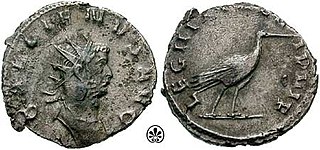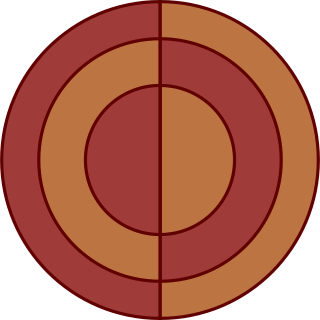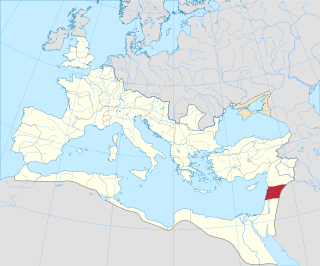Related Research Articles

Septimia Zenobia was a third-century queen of the Palmyrene Empire in Syria. Many legends surround her ancestry; she was probably not a commoner and she married the ruler of the city, Odaenathus. Her husband became king in 260, elevating Palmyra to supreme power in the Near East by defeating the Sasanian Empire of Persia and stabilizing the Roman East. After Odaenathus' assassination, Zenobia became the regent of her son Vaballathus and held de facto power throughout his reign.

Aurelian was a Roman emperor who reigned from 270 to 275 during the Crisis of the Third Century. As emperor, he won an unprecedented series of military victories which reunited the Roman Empire after it had nearly disintegrated under the pressure of barbarian invasions and internal revolts. Born in modest circumstances, most likely in Moesia Superior, he entered the Roman army in 235 and climbed up the ranks. He went on to lead the cavalry of the emperor Gallienus, until Gallienus' assassination in 268. Following that, Claudius Gothicus became emperor until his own death in 270. Claudius' brother Quintillus then ruled for three months, before Aurelian took the empire for himself.

Legio XII Fulminata, also known as Paterna, Victrix, Antiqua, Certa Constans, and Galliena, was a legion of the Imperial Roman army. It was originally levied by Julius Caesar in 58 BC, and the legion accompanied him during the Gallic Wars until 49 BC. The unit was still guarding the Euphrates River crossing near Melitene at the beginning of the 5th century.

Legio VIII Augusta was one of the oldest legions of the Imperial Roman army.

Legio XXX Ulpia Victrix was a legion of the Imperial Roman army. Their emblems were the gods Neptune and Jupiter and the Capricorn. Ulpia is Trajan's own gens, while the cognomen "Victrix" means "victorious," and it was awarded after their valiant behaviour in the Dacian Wars. The legion was active until the disbandment of the Rhine frontier in the beginning of the 5th century.

Legio III Italica was a legion of the Imperial Roman army founded in 165 AD by the emperor Marcus Aurelius for his campaign against the Marcomanni tribe. The cognomen Italica suggests that the legion's original recruits were drawn for the defence of Italy. The legion was still active in Raetia and other provinces in the early 5th century.
Legio III Parthica was a legion of the Imperial Roman army founded in AD 197 by the emperor Septimius Severus for his campaign against the Parthian Empire, hence the cognomen Parthica. The legion was still active in the Eastern provinces in the early 5th century. The legion's symbol was probably a bull.

Legio V Macedonica was a Roman legion. It was probably originally levied in 43 BC by consul Gaius Vibius Pansa Caetronianus and Gaius Julius Caesar Octavianus. It was based in the Balkan provinces of Macedonia, Moesia and Dacia. In the Notitia Dignitatum records from beginning of the fifth century, the legion was still stationed in Dacia, with detachments stationed in the east and Egypt.

The Legio I Maximiana was a comitatensis Roman legion, probably created by Emperor Diocletian in 296 or 297 AD. The legion was named after Maximianus, a colleague of Diocletian. The I Maximiana was formed together with II Flavia Constantia, to garrison the newly created province Thebaidos, in Aegyptus. As well as protect it from neighboring tribes. Since no Legio I Maximiana is listed as being stationed at Thebes in the Notitia Dignitatum, the designation is interpreted more broadly as of the Thebaid in general. The legion is also known as Maximiana Thebanorum or Thebaeorum. The cognomen Maximiana originated from Maximian, Diocletian's colleague.

The Legio II Flavia Constantia was a comitatensis Roman legion, created by Diocletian or Galerius, probably in the years 293, 296 or 297.

The Battle of Emesa was fought in 272 between the Roman armies led by their emperor Aurelian and the Palmyrene forces led by their empress, Zenobia and general Zabdas.

Legio III Diocletiana was a comitatensis Roman legion, levied in 296 by Diocletian, from whom the legion took its name. The aim of this unit was to guard the newly re-organized province of Aegyptus, being based in Alexandria. It was created to support II Traiana Fortis, and thus it took the numeral III.
Legio I Iovia was a Roman legion, levied by Emperor Diocletian (284–305), possibly together with II Herculia, to guard the newly created province of Scythia Minor. The cognomen of this legion came from Diocletian's attribute Iovianus, "similar to Jupiter". It was based at Noviodunum. According to Notitia Dignitatum, at the beginning of the 5th century I Iovia was still in its camp on the Danube. The legion may have even survived the fall of Rome and continued to serve the Byzantine empire.

Legio I Armeniaca was a pseudocomitatensis legion of the Late Roman Empire. The Legio I Armeniaca was likely created in the late 4th century by either Julian the Apostate or Diocletian. It is possible that the name of the legion could mean that it was originally part of the garrison of the Armeniac provinces. This unit, together with its twin legion II Armeniaca, appears to have been included in the imperial field army. It was based in Bezabde until the Persians captured the area in 360. The Legio I Armeniaca took part in Julian's invasion of the Sassanid Empire. The Notitia dignitatum records the legion as being under the command of the magister militum per Orientis around 400.

The Camp of Diocletian was a Roman military complex, or castra, built in the ancient city of Palmyra in the Syrian Desert. The complex was built under the Roman Emperor Diocletian in the late third-century CE and served as the military headquarters for the Legio I Illyricorum.

Phoenice was a province of the Roman Empire, encompassing the historical region of Phoenicia. It was officially created in 194 AD and after c. 394, Phoenice Syria was divided into Phoenice proper or Phoenice Paralia, and Phoenice Libanensis, a division that persisted until the region was conquered by the Muslim Arabs in the 630s.
The Siege of Tyana occurred in 272 CE. The forces of the Roman Emperor Aurelian were seeking to conquer the Palmyrene Empire.
Legio V Parthica was a legion of the Roman Empire garrisoned in Amida, Mesopotamia, established by the Roman emperor Diocletian (284–305), who reorganized the eastern frontier. The legion is described by the historian Ammianus Marcellinus. The cognomen "Parthica" was an archaism, as the Parthian Empire was already replaced by the Sasanian Empire at the time of the establishment of the legion.
The walls of Palmyra are a series of protective fortifications that providing customs barrier as well as protection for Palmyra from invaders and Bedouins. The development process of the walls can be separated into three stages; the first dates to the first century AD, and the second dates to the reign of the Roman Emperor Aurelian in the third century. The third was an improvement of the Aurelian walls commissioned by emperor Diocletian in the fourth century. The pre-Aurelian walls did not encircle the whole city and were not designed to protect it from conquest, but to provide protection from marauders. The Aurelian and Diocletian walls, although surrounding a smaller area, provided a higher degree of protection as they tightly enclosed the city.
References
- ↑ Kaiser, Anna Maria (2015). "Egyptian Units and the Reliability of the Notitia Dignitatum, pars Oriens". Historia: Zeitschrift für Alte Geschichte. 64 (2): 243–261. JSTOR 24433912.
- ↑ Hebblewhite, Mark (2016-12-19). The Emperor and the Army in the Later Roman Empire, AD 235-395. Taylor & Francis. ISBN 978-1-317-03430-8.
- ↑ Syvänne, Ilkka (2020-06-24). Aurelian and Probus: The Soldier Emperors Who Saved Rome. Pen and Sword Military. ISBN 978-1-5267-6753-0.
- 1 2 3 Pollard, Nigel (2000). Soldiers, Cities, and Civilians in Roman Syria. University of Michigan Press. ISBN 978-0-472-11155-8.[ page needed ]
- 1 2 3 "Legio I Illyricorum - Livius". www.livius.org. Retrieved 2020-10-19.
- 1 2 3 4 5 Intagliata, Emanuele (2018). Palmyra after Zenobia. Oxbow.
- ↑ Merrony, Mark (2017). The Plight of Rome in the Fifth Century A.D. New York: Routledge.
- ↑ Speidel, M. P. (1987). "The Roman Road to Dumata (Jawf in Saudi Arabia) and the Frontier Strategy of Praetensione Colligare". Historia: Zeitschrift für Alte Geschichte. 36 (2): 213–221. JSTOR 4436005.
- ↑ Whately, Conor (2021-06-22). Procopius on Soldiers and Military Institutions in the Sixth-Century Roman Empire. BRILL. ISBN 978-90-04-46161-1.
- ↑ Lemire, Vincent; Berthelot, Katell; Loiseau, Julien; Potin, Yann (2022-03-15). Jerusalem: History of a Global City. Univ of California Press. ISBN 978-0-520-29990-0.
